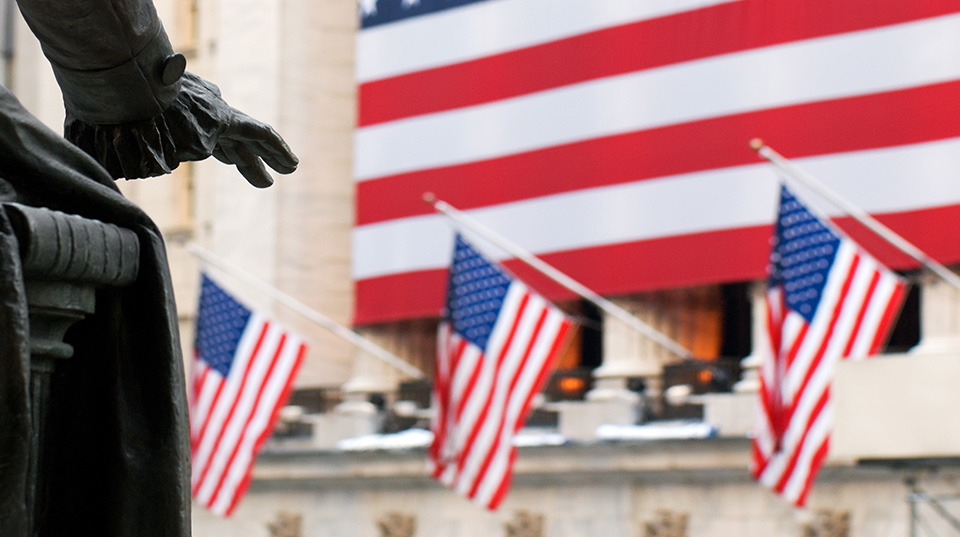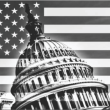by Hubert Marleau, Market Economist, Palos Management
May 23, 2025
Last week, I wrote: “The bulls definitely had the upper hand as the trade war waned and hard economics showed the economy held up: the US stock market is clearly not pricing in a recession and shows that businesses have been able to cope with intense headwinds, which is why I altered my own view on the trading range for the S&P 500 to 5500 and 6000 three weeks ago from a previous forecast of 5300 and 5600; and if I'm right on this one, the rally is due for a pause. Thus I think that the best thing investors can do right now is to sit tight and hold their ground because odds of a recession might be lower, but still are elevated, perhaps lightly adding to their preferred positions during dips to lower their cost averages.”
Moody’s Removed the USA’s Once Sacrosanct AAA Rating
Trump rolled back on tariffs, succumbing partially to Adam Smith’s free market and David Ricardo’s comparative advantage theories. Put simply, countries who wish to do business in the US will be debited a google baseline 10% levy on goods entering the US, and probably around 30% if a large trade deficit exists. Putting up trade barriers, like either quotas or tariffs, is actually a double-edged sword, with unintended consequences, history showing that countries affected by sanctions find ways around them, by soliciting new partners, releasing matching tariffs, courting black markets, or promoting attractive deals.
Consequently, the market will likely turn its attention to the Treasury market. Late Friday, after the close of the markets, Moody’s became the last major raters to strip Uncle Sam of its best grade, downgrading U.S. debt from its Aaa rating acquired in 1919 by one notch. (Standard & Poor’s and Fitch Ratings previously demoted him in 2021 and 2022 respectively, also by one notch.) Moody’s had 2 reasons for the assignment of a lower security classification: “First, successive U.S. Administrations and Congress (Republicans and Democrats) have failed to agree on measures to reverse the trend of large annual fiscal deficits and growing interest costs; and second, current fiscal proposals under consideration will not bring material multi-year reductions in mandatory spending and deficits”. At first glance, the one-notch downgrade should not have a huge market implication because US sovereign credit risk had already been on a rising path since the end of 2022. Moody’s was marking-to-market, and it can therefore be dismissed as a lagging indicator, according to Scott Bessent. Indeed, the US does not have to have a perfect rating score to lure investors: there are 21 notches on Moody’s scale, so one less notch does not amount to much. Based on the Bank of International Settlements’ risk-weighted capital asset calculations, the rating will not be impacted because they don't differentiate between Aaa and Aa1when setting risk-weights, either.
Nevertheless, it is still important because simple facts support the decisions of the 3 rating agencies. Debt held by the public now stands at $28.9 trillion, about 100% of the N-GDP: more worrisome is that total debt outstanding is now around 130%. (Only Australia, New Zealand, Canada, Denmark, Sweden, Luxembourg, Germany, Norway, Singapore, and Switzerland have better ratios, thereby meriting the top grade.) As a consequence, the fiscal deficit ran at 6.5% of N-GDP in 2024, a level not seen outside of wartime periods. By all accounts, an amelioration in the US's credit standing is out of the question for now: DOGE is tapering off, and the “Big, Beautiful Tax Bill” (BBTB) currently worked on is worsening the fiscal outlook.
The Joint Committee on Taxation estimated that BBTB, including the renewal of the Tax Cut and Jobs Act of 2017, would increase the fiscal deficits by $3.8 trillion through 2034, equal to 1.1% of N-GDP, while the Bipartisan Policy Center calculated that if the “BBTB” were extended permanently, the deficit would be worse: $5.3 trillion higher, or 1.5% of N-GDP. That would take the debt/GDP ratio to either 8.1% or 8.5%, given the current run rate for 2025 of 7.0%. According to the Penn Wharton Budget Model, the “BBTB” would increase the “primary” deficit, which excludes interest costs, by $6.0 trillion over 10 years.
The fact is that this spending problem is unsolvable. Around 75% of it is mandatory: 60% on programs like social security, Medicare and Medicaid with another 13% covering interest of existing debt. The final 27% covers defence (12%), plus education and infrastructure (13%), all of it core expenditures.
This prospect of even larger fiscal deficits brings about 2 overriding problems. It makes it nearly impossible to rectify US trade deficits without a huge increase in corporate profits and personal savings, or to finance such deficits without massive funding from non-Chinese foreigners, because of an ongoing shift in Beijing’s management of its foreign reserves away from US Treasuries. Indeed, the math just doesn't work well enough to recreate an economy that would resemble the twin surpluses of the 1950s. Regrettably, this is an increasingly serious issue because all too many who bought the false hypothesis that fiscal deficits have nothing to with trade deficits, have drunk too much Kool-aid, dreaming in Technicolor that the sole imposition of tariffs would on it own, solve the trade imbalance between the US and the rest of the world.
Thus political dysfunction means this trend could deteriorate further. The trouble is, nobody really knows when the “then” might become the “now”, and by the time we hit ‘now’ it could be too late: forex, bond and stock markets would freak out. Callie Cox, chief strategist at Ritholtz Wealth Management, summarised the situation well, saying: “The government deficit isn't a problem until investors think it is”.
She may be right, unless the promise of pro-productivity policies delivers the necessary growth path to rectify the twin-deficit issue. This is why Bessent is so keen on producing growth when considering the net national savings rate of the U.S. is -3.1% of N-GDP (-7.0% budget deficit +3.9% personal savings rate), according to Andrew Lees of Macro Strategic Partnership, who is of the opinion that the only way to arrest the fiscal deficit problem with some political acceptance is through pro-growth public sector spending. Counterintuitively, he’s gambling that public sector deficits will become private sector savings, like they did during the Covid-pandemic and that higher tax receipts will come from more people in the workforce with the help of more productivity, like it did during the 1990s.
This is more than a mere possibility. In this connection, investors should watch the market behaviour of the exchange value of the greenback and long-dated Treasury yields for answers, because that is where funding problems would show up first, if it were to come to that. It will indeed become increasingly important to monitor these 2 markets because the trajectory of trade and debt has become so interwoven that they will graphically illustrate foreign appetite for US Treasuries, US dollars and US risk assets.
At present, so-called forex and bond vigilantes are running the show, because they are effectively an outside branch of the government, which has as much veto power as Congress and is therefore able to impact final decisions. Their effect has already been felt: since April 4, there have been 4 big movements in key markets that demand more fiscal discipline:
- The market volatility of long-dated US Treasuries and the US dollar has outstripped significantly that of stocks. For example, the Move - a reflection of bond volatility - is 5.7 times more volatile than the VIX, a reflection of stock volatility versus 2.8 times; while the VIX is only 2.0 times more currency volatility versus 5.4 times.
- The term premium for long-dated Treasuries accounts for the bulk of the 50 bps of the 65 bps increase in its nominal yield, which is currently 5.05%.
- The performance of the dollar has been under considerable pressure; the DXY having lost 4.0% of its forex value.
- The price of gold has risen 12.2% to $3358.
Investors should also be conscious that the extension of the 2017 tax reform and technology infrastructure spending are also big features in Washington that could catapult into more productivity growth, especially if the Administration decides to ditch the reciprocal tariff proposal. With a bit of luck, it is even conceivable the US could upgrade to a 3-plus-3 economy from 2-plus-2: that is 3% for growth and 3% for inflation.
So What Went On Last Week, Ended May 23?
On Monday, the S&P 500 fell quickly after Moody’s stripped the U.S. of its top credit rating, bringing tremors as the CBOE Volatility Index, the so-called fear gauge, surged 15% to 20.0, around its long-run average; but it rebounded in the afternoon as the dippers waded back in, believing that Moody’s action was largely symbolic, reflecting information the market already
knew. Although the benchmark settled at 5964, up 0.1%, markets did not finish the day unscratched, gold having risen 1.2%, the dollar falling 0.7% and long-dated bonds proving volatile.
The stock market momentum couldn't last forever. Once again, gold rose, the dollar fell and the 30-year Treasury yield sour on Tuesday, with the S&P snapping a 6-day win streak and falling 0.4% to end the day at 5940.
On Wednesday, stocks had their worst day in a month, reflecting worries over lack of progress on trade talks and growing concerns about the U.S. fiscal policies. This anxiety sparked a big increase in bond yields and huge declines in the exchange rate for U.S. dollars.
On Thursday, the BBB to cut taxes and spending passed the House of Representatives by one vote, heading to the Senate, where changes are expected. At first in the early hours of the session, the vigilantes barfed all over it, as 30-year Treasury yields shot up to 5.15%. Meanwhile, the S&P shed less than 0.1% in choppy trading.
On Friday the S&P 500 was down 0.7%, closing at 5803. The market did not appreciate Trump’s plans to levy a 25% import tax on foreign made i-Phones, and slap a 50% tariff on all imports made in the EU, declaring that the trade talks were going nowhere.
The Near-Term StockMarket Outlook
I still have a 6000 target for the S&P 500 for 2025. Interestingly, flying in the face of menacing vigilantes, several market strategists are revising upward their S&P 500 targets, and seem to be taking a longer view than they usually do. For example, Morgan Stanley, including its chief economist, has turned very constructive on US stocks, predicting that the S&P 500 will reach 6500 by the end of the 2nd quarter of 2026 as the base case and possibly 7200 as the bull case. Meanwhile, UBS has hiked its S&P 500 target to 6400 for June 2026. These bullish conjectures are based on dollar weakness, realisation of AI-driven efficiency gains, and rate cuts, plus an expansionary policy agenda, including incentivising infrastructure investment, tax breaks, and deregulation.
Copyright © Palos Management














